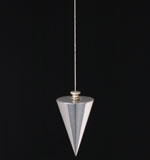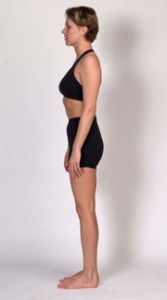Bones support the body much the way a steel framework supports a skyscraper, providing support, shape and protection to the organs of the body.
At the center of this skeletal structure the pelvis is located. It is the largest bone complex of the body and serves as the foundation of both posture and movement.
The spinal column is well named because it literally functions as a column resting vertically upon the pelvis and supporting the shoulder girdle and skull.
Similarly, the legs function as columns designed to bear the weight of the body equally.
Gravity
 Gravity is a constant force that is pulling you down toward the earth’s surface every minute of every day of your life, creating friction and weight in the process.
Gravity is a constant force that is pulling you down toward the earth’s surface every minute of every day of your life, creating friction and weight in the process.
Gravity works in a straight line. Objects fall in a straight line.
Your skeletal system is the most stable, therefore, when it is aligned with the force of gravity.
Structural Alignment
All structures require that the load bearing elements are aligned with the force of gravity. The columns and beams of a building, for example, must all be in alignment with the force of gravity in order to stabily support the loads of the building.
From a structural standpoint, your body is in stable alignment when the eight major load bearing joints found at the shoulders, hips, knees, and ankles be above and next to each other at right angles and when viewed from the side the head, shoulder, hips, knees, and ankles all rest vertically on top of each other.
 A properly aligned musculo-skeletal system is structurally stable, permitting long hours of comfortable sitting, standing, and moving.
A properly aligned musculo-skeletal system is structurally stable, permitting long hours of comfortable sitting, standing, and moving.
Should postural deviations develop, however, the whole structure starts wrenching out of alignment. A twisted pelvis is a very common condition, for example, in which some of the largest muscle groups of the body no longer keep the pelvis level from left to right and properly angled from front to back. A twisting pelvis can send out shock waves in all directions. Upward, the vertebrae, shoulders, elbows wrists and fingers are all forced to function out of alignment. Downward, the hip sockets, knees, ankles, and toes likewise stop functioning within their planes of motion and churn in all directions during each movement.
Bone Loading
Your body is structurally designed to transmit your body weight through the skeletal system not the muscular system. Such alignment with the force of gravity allows for what is called “bone loading” whereby the body’s weight is mechanically transferred through the bones to the ground rather than having to be carried by your muscular system. The postural muscles work to maintain vertical alignment from front to back and left to right, but the overall musculature is at rest in that it is not being used for load bearing Such proper structural alignment requires minimal energy, while extending maximum ease of movement to the joints. Such efficient use of energy allows you to remain fresh and focused from sunrise to midnight.